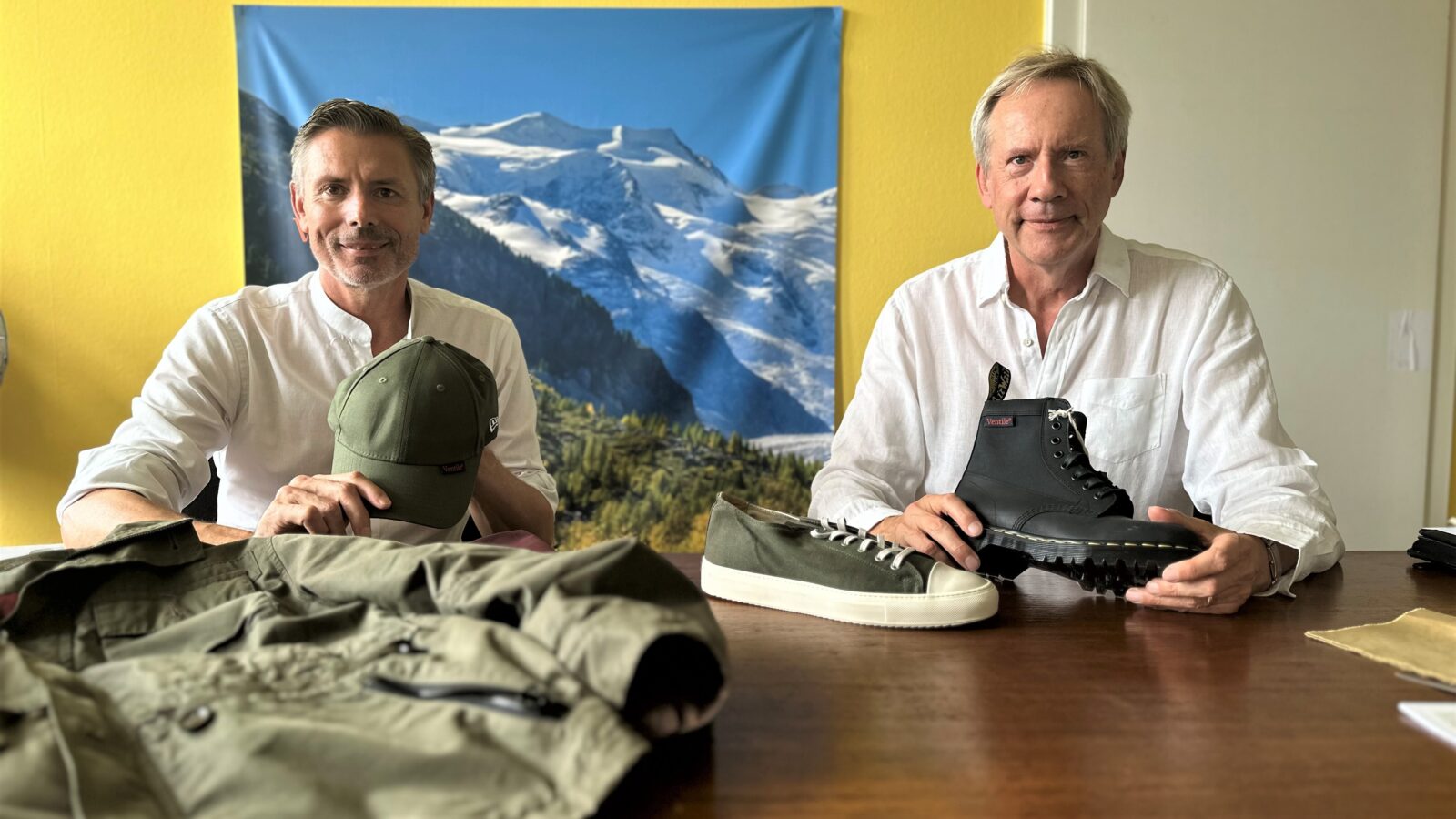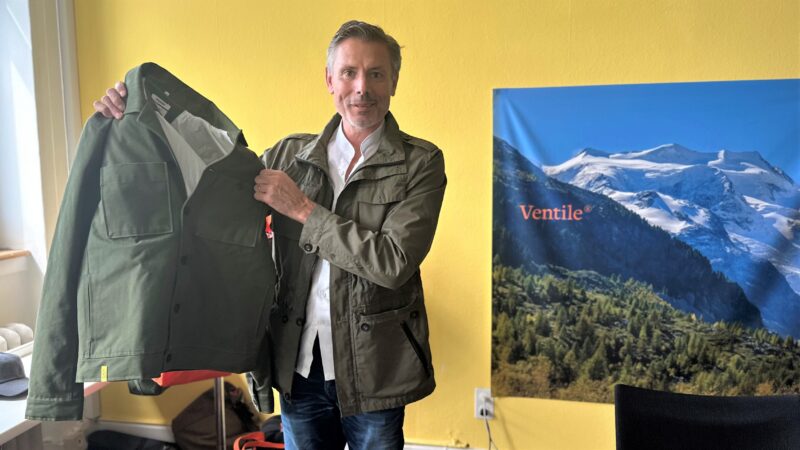80 years of Ventile
“We are always working at the boundary of what is technically feasible”

The British cult brand Ventile is 80 this year. Swiss Textiles spoke to Brand Director Daniel Odermatt and Thomas Stotz, owner of the parent company Stotz & Co. AG, about exceptional orders, army uniforms – and Agent 007, James Bond.
In 2017, the Swiss Stotz & Co. company acquired the Ventile Fabrics brand from Talbot Weaving, for which Stotz had previously been manufacturing for many years. The Ventile fabric was developed back in the 1930s at the Shirley Institute in Manchester. Talbot Weaving founded the business of the same name in 1943 in order to supply special garments to Royal Air force personnel during the Second World War, according to the company’s historical records. The fabric is reported to have been used in 1953 during the first ascent of Mount Everest and on an expedition to the Antarctic between 1979 and 1982.
Swiss Textiles: Your Ventile brand will be 80 this year. What are you doing better than your competitors?
Daniel Odermatt: We supply the world’s densest organic cotton fabric. Ventile has unique technical properties.
Thomas Stotz: It is even breathable and unlike the Barbour jacket not coated. That is an advantage over synthetics which are admittedly waterproof but laminated, making the wearer perspire heavily.James Bond wears a Barbour model in “Skyfall” creating real hype. Will the next agents be wearing a Ventile model?
DO (laughs): We have not given that any thought. But after all you must have goals for the future ...
On the contrary, I am thankful that we are still here.
What makes you proud when you look back at your company’s history?
TS: Proud is not the right word. On the contrary, I am thankful that we are still here. When I remind myself that my uncle set up Stotz Fabrics in 1939 – even before the outbreak of the Second World War – and that we have been close to going under on occasion. I have now been with the business for 40 years. Switzerland as a manufacturing site has unfortunately changed for the worse. That is why I am also thankful that our headquarters is located here in Zurich, in one of the world’s most expensive cities.
Ventile is still supplying the English army. You must surely be proud of that.
TS: Not just the English army, also the Swedish! When the English Ministry of Defence placed an order for protective wear for its armed forces with us in 1996 we were particularly proud. We were able to outclass the company that had been manufacturing for them previously. We also welcomed the sales revenue.
How did you win this order?
TS: Talbot Weaving, Ventile’s former owner, had been supplying the English Ministry of Defence with protective wear for the armed forces. In 1995, the Ministry’s clothing supplier contacted us because it was no longer satisfied with its manufacturer’s quality. At the time we were already capable of making this particularly dense fabric. We set about producing several trial batches. However, the first two trials proved unsuccessful.
Why?
TS: Our protective suiting which we submitted was made of twin-layer cotton fabric, in an enormously dense weave and with elastic closures to prevent water penetration. The clothing supplier tested the samples in great detail before passing them on to the Ministry of Defence. Unfortunately, the garments turned out not to be waterproof. But one year later we made the breakthrough.
The first two trials were failures.
You make repeated references to sustainability on your website. What do you mean by that?
DO: We are constantly expanding our range of fabrics made from recycled and organic cotton. What is more, our products have been PFC-free since 2021. I am particularly proud of that achievement. But we had already recognized the trend when we acquired Ventile. That brand has set great store by sustainability for a long time.
However, cotton uses enormous resources of water and farmland. Can that still be justified in this day and age?
DO: Yes, that is a problem. But the pesticides and fertilizers that are used present a still greater problem. That is why we are making increasing use of organic cotton grown without chemicals. The water for Egyptian cotton comes from the Nile which is an adequate source of supply for the cotton plantations in the Nile delta. So nobody is being deprived of water here.
Does this differ from other cotton varieties?
DO: We only use rare extra-long staple cotton from Egypt and the USA. Its fibres are fine, long and strong enough to weave. But this represents just two per cent of world production. We also use organic cotton which in turn accounts for just two per cent of total output. This combination represents 0.04 per cent worldwide. That percentage shows the real difficulty of procuring the material. The fine yarn must then be spun uniformly. Afterwards two yarns are twisted together to obtain a coarser and stronger material. Then we move on to weaving, dyeing and finishing.
The pesticides and fertilizers that are used present still greater problems.
It sounds like hard work.
DO: Yes it is. Weaving requires vast knowhow. We found that out again two years ago when our Swiss weaving partner closed down because of the pandemic. We had to start again from square one. Only a handful of weaving mills in Europe are able to meet these quality standards. The weave density of our fabrics is roughly one-third higher than that of current fabrics used to make cotton coats. Because our weaving technology is so exacting we are constantly working at the very limit of what is technically feasible. So, we had to spend a great deal of time and energy to bring our weaving partners up to this level.
I suppose that not everyone can afford your garments.
DO: Yes, we are in the upper price segment. Our most affordable parka jackets start at 350 pounds. But some fashion labels charge as much as 2000 pounds.
How many of them do you have in your own clothes cupboard?
DO: I myself own eight garments! Gilets and blazers, coats and outdoor jackets. After all, I must test them out regularly. But my favourite is the “M65 Field Jacket” model.
TS: Two – one jacket and one coat.
So few?
TS: Yes, because our products last for a lifetime. Slow fashion is our motto.
No suitable weaving partners in Switzerland
Today Ventile has its materials woven in Egypt, Austria, Italy and Turkey. “There are no longer any suitable partners in Switzerland”, Daniel Odermatt comments. Highly robust rapier looms would be needed instead of the air jet weaving machines that are so widely used today. Odermatt and Stotz see great potential for bags and footwear as future markets. Odermatt comments that the company plans to become “fully circular” in future.


